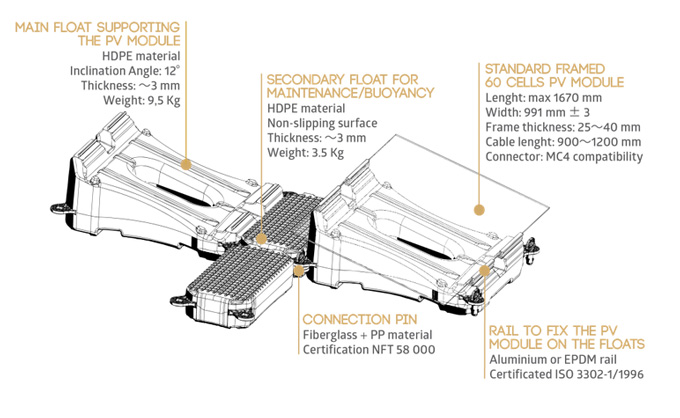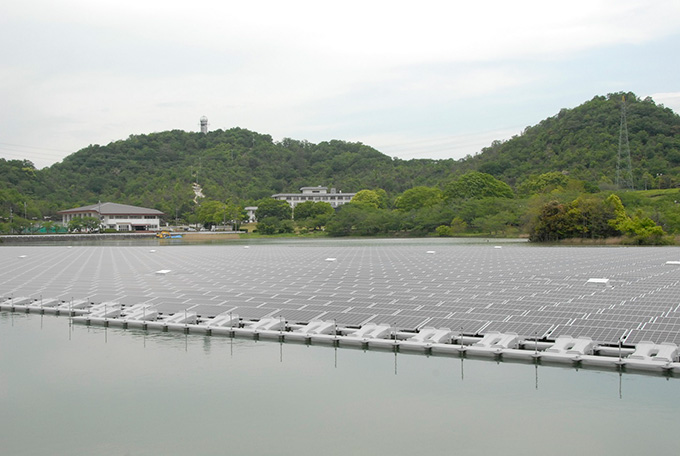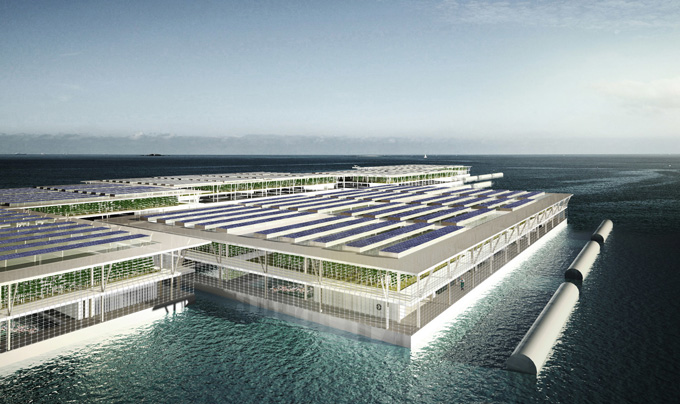With nearly 3 quarters of our planet covered with water, and more and more people living and feeding from the increasingly scarcer lands, isn’t it a brilliant idea to start using our water surfaces for clean power generation?
Makes perfect sense, right?
With only a handful of players currently focusing on the market of floating solar systems, it seems there’s more to it than you might think.
In this article, we explore the countries where floating solar is taking off, the main players and their different technologies as well as the advantages and implications of installing solar modules on the water surface.
What are the main countries where floating solar systems are installed?
Yossi Fisher, CEO of Solaris Synergy, a pioneer in floating solar systems comments:
“The Floating PV market is a new growing market. There are many places around the world that do not have available land for PV installations, mainly islands such as Japan, Singapore, Korea, the Philippines, and many others.
In general, the cost of the water surface is much lower than the cost of land.
Today there is already a demand for Floating PV in Japan, the USA, Korea, Australia, Brasil, India, and others. This demand is expected to increase and will spread all over the world”.
What are the ideal places for floating solar systems to be installed?
We’ve read about floating solar systems being installed at wineries, fish farms, wastewater treatment plants, and so on.
Yossi Fisher continues:
“An ideal match are the water utility companies that are usually heavy electricity consumers that do not have land but have many water reservoirs.“
Also, there’s a good synergy with Hydro-dams since the infrastructure, such as the electrical grid, teams, and roads, is already in place.
Floating solar systems vs. solar systems installed on land – which system produces more power?
Solar PV systems installed on the water surface benefit from a significant lower ambient temperature due to the evaporative cooling effect of water. The aluminum frames certainly conduct the cooler temperature from the water as well, bringing down the overall temperature of the modules.
However, the actual performance advantage compared to ground-mounted installations seems to vary due to lots of variables.
We highly doubt the comments made by the company Infratech Industries claiming yields of up to 3 times that of a traditional fixed solar system are possible (Source).
Perhaps a more realistic scenario comes from research done by the Korea Water Resources Corporation:
A study conducted by Korea Water Resources Corporation has shown that floating PV systems can outperform standard, land-installed PV systems by 11% (!).
THAT IS a significant difference.
During this comparison analysis, the performance of 3 installations, sized 2.4kW, 100kW, and 500kW was measured. Each system had the equivalent power installed on land, as well as on the water.
Comparison study floating solar systems by Solar Energy Research Institute of Singapore (SERIS)
Another study to keep an eye on.
The government of Singapore is undertaking the largest side-by-side comparison study of floating PV systems, which is managed by the Solar Energy Research Institute of Singapore (SERIS).
“This SGD11 million project will be held in two phases over a period of 4 years, and in phase one, starting in 2015 will deploy eight floating PV systems, each with a capacity of around 100 kWp. Phase Two, which commences after the PV systems of Phase One have been comparatively tested for several months, will see an expansion by another 2-3 MWp in size. More details can be found on the SERIS website http://www.solar-repository.sg/” (Source)
How about waves and heavy winds?
Floating solar systems will certainly move by waves and heavy winds. The floating PV system needs to be able to withstand these forces of nature.
Ciel & Terre’s floating solar technology called Hydrelio© is tested by ONERA (the French aerospace lab) to withstand winds up to 190km/h (118mp/h).
Solaris Synergy’s cable-based structure is able to withstand hurricane-level winds as well. The question is perhaps.. what kind of hurricane? 🙂
Another float or raft membrane developed by Infratech Industries Inc is able to withstand up to 10 meters in water level differential and 2-meter peak and trough waves.
How about floating solar systems on salt water / open sea?
With over three-quarters of our planet covered in water, a logical question step would be the deployment of floating solar energy systems on the open sea. Is this already possible?
Solaris Synergy comments:
Our floating system can stand waves up to 2 meters and can be installed in lagoons or bays.
The problem today with salty water is that the PV modules manufacturers are not ready yet to give warranty for salty water installations.
If the PV module manufacturers are not ready yet to offer decent warranties on modules installed at sea, we may need ‘military grade‘ modules for ocean projects, or limit the installation of floating solar systems to sweet water lakes for the moment.
What are the effects of salty water on solar modules?
It’s known that Salt Mist Corrosion can affect the lifetime of solar modules that are installed near a coast line.
Manufacturers nowadays offer a special certification too prove that they can produce modules that can withstand salt mist corrosion according to specific standards. This Salt Mist Corrosion standard is the IEC 61701.
As you know from our previous article on the pitfalls and difficulties concerning solar module warranties, the details of a warranty vary greatly and are easily void if modules are not handled and installed as per warranty conditions.
Anything installed at sea needs to be corrosion-proof and apparently, most PV manufacturers of standard solar modules are not confident yet to offer full warranties on modules installed at sea.
In fact, most solar module warranty policies exclude modules ‘exposed to corrosion’.
Here’s an example quote from Trina Solar’s warranty policy:
…”Limited Warranty” does not apply to any Products which have been subjected to extreme environmental conditions or exposure to corrosion, oxidation”
What are the main players of floating solar systems in the market?
Solaris Synergy
Solaris Synergy’s proprietary technology is different from most rigid contiguous floating platform solutions on the market. Its floating equipment has already reached a cost equivalent to ground-mounted PV systems.
The company’s proprietary ‘Grid-Based Solaris Synergy system’ “…enables PV modules to float independently of each other while maintaining a predefined geometrical configuration by means of a proprietary system of tensed cables connected in a spider-web like grid and supported by a rigid floating rim.
Imagine a structure similar to a tennis racquet, where the floating rigid rim is the frame of the racquet, and the grid of tensed cables are the strings of the racquet running lengthwise and width wise. In the squares formed by the criss-crossing strings – the solar modules are placed and are loosely held to the corners of the squares with cables”.
(Whitepaper)
Ciel et Terre
Ciel et Terre’s HYDRELIO© floating solar system components consists of patented modular floats that are known for their ease of installation. The system can be put together without any tools.
Interesting FAQ about materials used by Ciel et Terre: http://www.ciel-et-terre.net/faq/
Visit Ciel et Terre’s website http://www.ciel-et-terre.net/
- Kyocera
In the past years, Kyocera TCL Solar has been rolling out large-scale PV systems in Japan. Due to the lack of space, and the abundance of unused water surface, the company has been constructing several floating solar PV systems.
The latest and third floating solar system, a 2.3MW installation, was constructed in Hyogo Prefecture, Japan. The floating structure is supplied by Ciel et Terre. At the moment the largest floating solar system in the world!
The company is currently working on a new giant 13.4MW installation, which will be floating on a dam reservoir in Chiba Prefecture.
Other companies doing work with floating solar systems are Infratech Industries Inc and Sunengy (floating CPV),
What are the components/materials used for floating solar systems?
A typical floating solar energy (PV) system consists of the following components:
- A floating system, consisting of either a Pontoon or separate Floats:
- Pontoon -> a pontoon is a flotation device with buoyancy sufficient to float itself as well as a heavy load.
- Floats -> often multiple plastic floats are combined, forming a giant pontoon. The floats are typically made of HDPE (high-density poly-ethylene), know for its tensile strength, UV, and corrosion resistance. One important advantage of floats made of HDPE is that these can be used in drinking water reservoirs. HDPE is commonly used for the fabrication of milk bottles, water pipes, fuel tanks, and so on. HDPE can be recycled as well.
- Mooring system, a mooring system usually refers to any permanent structure to which a vessel may be secured. Examples include quays, wharfs, jetties, piers, anchor buoys, and mooring buoys. In the case of a floating solar system, the mooring system keeps the panels in the same position and prevents them from turning or floating away. The installation of a mooring system can be a challenge and expensive in deep water. Not all companies are using a mooring system. For instance, Israeli company Solaris Synergy does not use a mooring system and uses their patented grid-based system which secures the floating solar modules as well.
- Solar panels, right now standard solar modules are used for the floating solar systems we’ve seen installed so far. However once more projects will be installed on salty water surfaces, we expect that specially fabricated modules will be required to resist the long-term salt mist exposure. Nearly any metal will corrode over time and therefore there are alternatives to standard aluminum frames and mounts, such as the following polymer made frame from Suntech Power, which does not corrode at all:
- Cables. Electricity is drawn from the solar array and transported to the land. At land, the power can be fed to the grid, or stored in batteries. The projects we’ve been informed with so far did not have cables pulled under water, but kept wiring above water. Even though no electrical components are under water, properly rated cables and waterproof IP67 junction boxes are important with floating solar projects. Other electrical components such as inverters and batteries remain ’nice and dry’ on the land.
The future of floating solar systems?
One nicely thought out concept that we like to highlight here is the solar-powered Smart Floating Farms (SFF) concept developed by Forward Thinking Architecture.
The concept of an autonomous floating farm was developed as a solution for our future food shortage: with an estimated 9 billion mouths to feed by 2050 and climate change likely cutting a quarter of crop yields, we’ll need new, innovative ways to increase food supplies.
The farm is built with a modular-expandable Multi-Layer Floating Farming system and is designed to operate at sea. The Hydroponics, Aquaponics, LED lighting system and desalination equipment will all be solar powered.
Javier F. Ponce, CEO of Forward Thinking Architecture comments:
“There are many areas/dense cities worldwide that can benefit from our Smart Floating Farms (SFF), specifically the countries with land scarcity and massive import related problems, and limited water resources.
For example, the project could perfectly fit in places like Singapore or the Arabian Peninsula countries, and many other countries..”
SINOVOLTAICS: Do you consider building a prototype?
“Yes, it is actually becoming more and more real with time and our progress. We will be glad to comment more when the appropriate time comes.”
TO OUR READERS:
Do you have experience with floating solar (PV) systems or a working on a water surface PV system? We want to hear from you, please comment or mail us!


















Nando
on 09 Nov 2017Luciano Mule'Stagno
on 01 Jun 2017Trinhla
on 23 Mar 2018Rene Moerman
on 18 Jan 2018Bob A.
on 21 Mar 2017marco
on 26 Feb 2022mauro
on 25 Oct 2016ali
on 13 May 2016marco
on 26 Feb 2022suzan
on 14 Jul 2016marco
on 28 Dec 2018Glenn
on 21 Jan 2016maria
on 14 Dec 2015Dricus
on 15 Dec 2015Ingryd P
on 18 Nov 2015Dricus
on 18 Nov 2015Judith Smadja
on 15 Aug 2015Dricus
on 18 Aug 2015Minwoo Kim
on 19 Aug 2015Minwoo Kim
on 10 Aug 2015Dricus
on 13 Aug 2015Maarten Romijn
on 20 Aug 2016